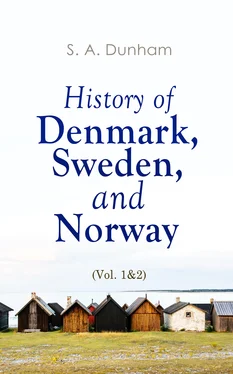Whether Odin ever existed—whether himself and his alleged Asiatics are not mere creatures of the imagination—whether they are not purely mythologic, and referrible to an Asiatic source, at a period lost in the depths of antiquity, have long exercised the ingenuity of writers. In matters of pure history it is certainly better to err on the side of scepticism than of credulity; but in the present instance we cannot discover sufficient grounds for the former opinion. That he existed, and at no distant period antecedent to the invasion of England by the Saxons, is affirmed, alike, by written testimony and tradition. According to that venerable and most inestimable relic of antiquity, the “Saxon Chronicle,” all the princes of the nation derived their origin from the deified hero; and the number of generations between him and the reigning king are minutely recorded. Thus, from Odin to Cerdic, A.D. 495, are ten generations; from Odin to Ida, A.D. 547, the same number; from Odin to Ella, A.D. 560, twelve; from Odin to Ceolwulf, A.D. 597, thirteen; from Odin to Penda, A.D. 626, twelve; from Odin to Offa, A.D. 755, sixteen; from Odin to Ethelwolf, A.D. 854, twenty-three generations. In all these lists the intervening chain, from the wizard king to his Saxon descendant, are carefully specified. In the same manner the series of northern kings, from the sons of Odin, who were placed by him over the thrones of Denmark, Sweden, and Norway, is progressively detailed. Thus, in Denmark, the generations from Skiold, the son of Odin, to Ragnar Lodbrok, A.D. 794, are twenty-five. In Sweden, from Niord (the adopted son, perhaps, of Odin) to Olaf, A.D. 630, are twenty-three generations. In Norway, the succession of kings from the same Niord, to Harald Harfager, the first monarch of that country, A.D. 934, are twenty-eight. We think that these genealogical series, so carefully, so minutely particularised, afford a presumption, at least, that the pontiff king of the north both lived and reigned at a period not very far distant from our Saviour’s birth. Not that the subject is without its difficulties. The events ascribed to Odin’s times have, by many writers, been deemed inapplicable to any century within the known history of the world. Hence, some have removed him to the age immediately following the flood; some, to the seventh century after that event; some, to the age of Darius Hystaspes; others, to that of Philip, king of Macedon; others, to less than two centuries before Christ; while another party contends that he was more recent still, and that Ariovistus, whom Cæsar conquered, was one of his sons. Where so much contradiction, so much absurdity abound, our only guide, in the absence of positive evidence, is reason; and this confirms the generally received opinion, that this personage is of far less antiquity than was formerly supposed. Not that many of his rites, many of his notions, many, perhaps, of his alleged actions, are not more ancient. There is, indeed, some reason to infer that they were known in Asiatic Scythia, a thousand years before his time. But this fate is not peculiar to Odin; it has been that of all celebrated men. Whoever has entered profoundly into the history of tradition, must be aware that legends which were formerly applicable to the most ancient characters, were applied to comparatively modern ones, when the latter had been dead long enough to permit the imagination to invest them with new attributes. Thus, many which have been related of Charlemagne’s heroes—of Charlemagne himself—of the crusaders, especially of our Cœur de Lion’s age, were once the glory of pagans, and were derived from a northern or an oriental source, before Normans, Franks, or Angles were known. [32]
So much for direct and positive evidence, which is strongly confirmed by inference. The Goths, like all the Scythians, were accustomed to deify their deceased heroes. This is expressly affirmed by several writers, especially by Adam of Bremen; and heroes are mentioned, who, we find, were deified. Thus, Armin, or Ermin, the courageous supporter of Germanic independence against the Romans, was worshipped as a god; and his famous idol, which was called, after his name, Irminsul, drew multitudes of pagans to the Isle of Rugen: it was, indeed, regarded as the palladium of Germanic liberty. The facility with which kings and heroes were deified is still more strikingly illustrated in the life of St. Anscar, the apostle of the Scandinavians. Alarmed at the success which attended the preaching of that admirable missionary (this was about the middle of the ninth century), the priests of the Odinian worship had recourse to a bold imposture. By their contrivance a man suddenly appeared in the Swedish capital, who affirmed that he had just attended a general meeting of the gods, and that he was bearer of a communication from them to king Olaf and his people. The substance of it was, that the ancient deities had always been most indulgent to the Swedes; that, hitherto, they had found no reason to complain of an ungrateful return from their worshippers; that now, however, there was a sad decline in the sacrifices and other proofs of devotion; and that their wrath was especially excited by the introduction of a new deity—of one peculiarly hostile to the gods of the kingdom. “If,” added they, “you Swedes really wish to increase the number of gods, we will readily admit your departed king, Eric, to the honours of deification.” That the proposal was accepted—that a temple was immediately erected to Eric—that his altars perpetually smoked with sacrifices—are among the most indubitable facts of history. Hence, there is nothing unreasonable in the deification of Odin; indeed, he could not have avoided the honour. One so celebrated as he was—a great warrior, a great legislator, the founder of a new empire, and of a new religion—assuredly could not fail to be invested with the same honours as an Armin or an Eric. Indeed, as it was the obvious policy of the Asiatic followers of Odin to represent the authority of their pontiff king and his successors as founded on divine, not on human, sanction—as that authority was avowedly theocratic—he must, of necessity, have been regarded as a god, if not in his lifetime, immediately after his decease. [33]
The temporal no less than the spiritual government of Odin, and the social superiority of his immediate followers over the inhabitants he found in Sweden, drew our attention in the early pages of this Introduction. Our opinions on this subject are strongly confirmed by a judicious living writer. “Odin founded the empire of the Sviar, which was originally confined to a small territory around the Mœlar Sea, in the present Swedish province of Upland, called the lesser Svíthjód, in contrast to the greater Svíthjód, or Scythia, whence they migrated, and Mannaheim, or the Home of Man, in contrast to the celestial abode of Asgard. By degrees the Sviar, as the leading tribe governed by the pontiff kings, the immediate descendants of Odin, and having the custody of the great temple at Sigtun, the principal seat of the new superstition, acquired an ascendancy over the Goths, who possessed the more southern tract of country called Gautland, Götland, or Göta-rike. This precedence of the Sviar over the Goths is established by the express terms of the ancient fundamental law of their joint empire, according to which the ‘king was elected by the national assembly of all the Swedes ( å Ting allra Svia ), at the Mora-Stone, in the plain near Upsal, and the assembly of all the Goths ( Ting allra Göta ), shall re-elect or confirm him.’ [34]This distinction between the two tribes is constantly preserved in the traditions and annals of the middle ages, and the division between the Svia and Göta-rike is strongly marked by a chain of mountains running between Södermanland and East Gothland. It is also recognised at this day in the constitution of the supreme judicial tribunals called the Svea and Götha Hofrät, established during the reign of Gustavus Adolphus, and to which a third has been recently added for the provinces of Scania and Bleking.”
Читать дальше












